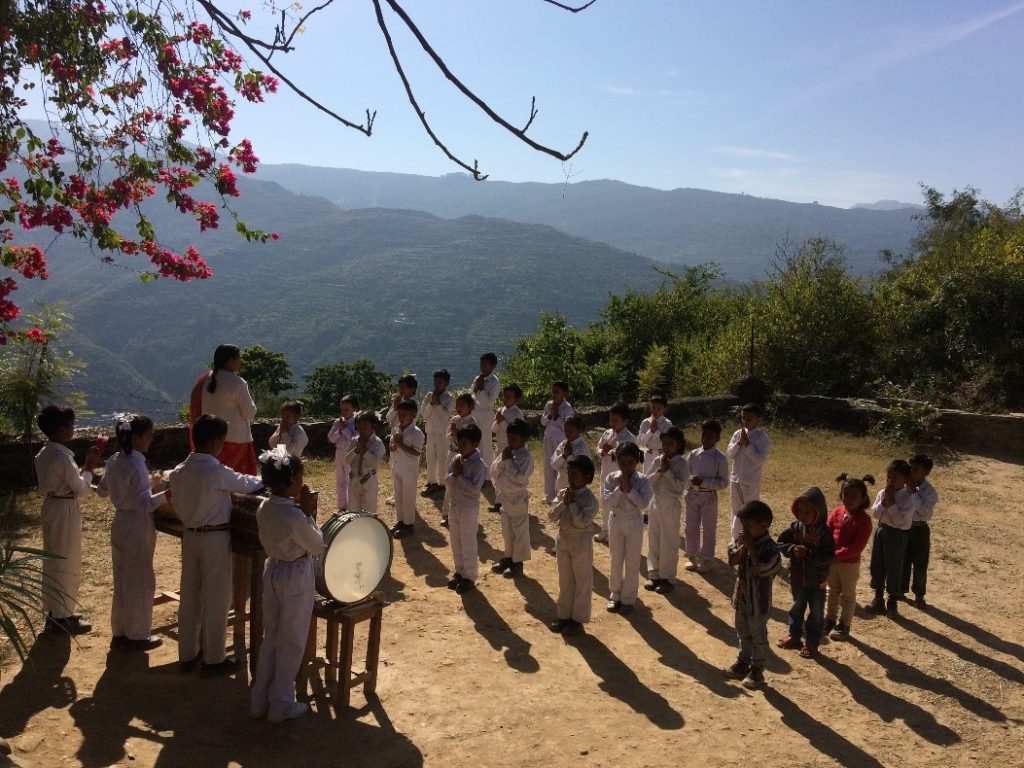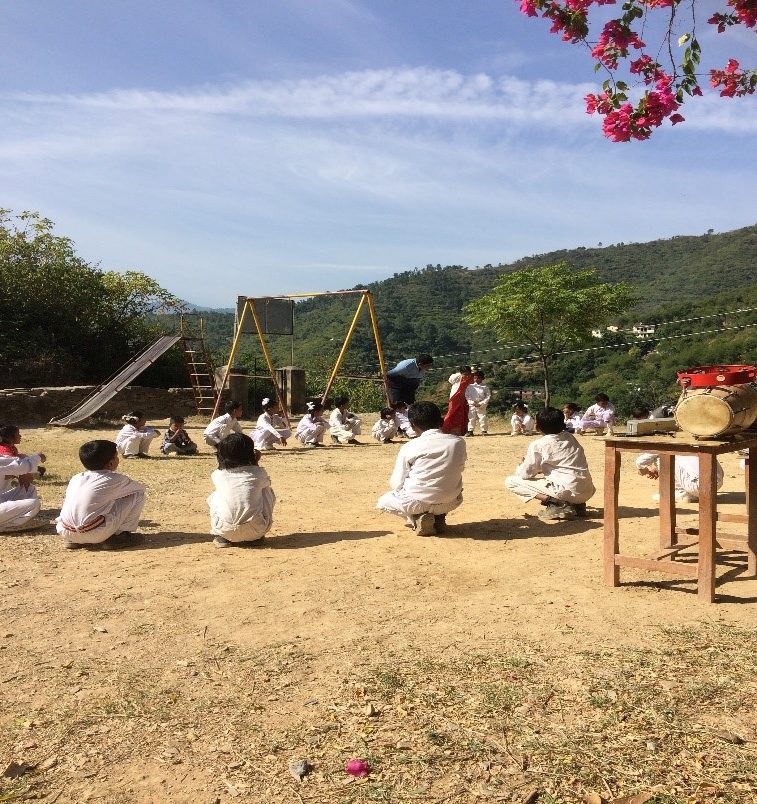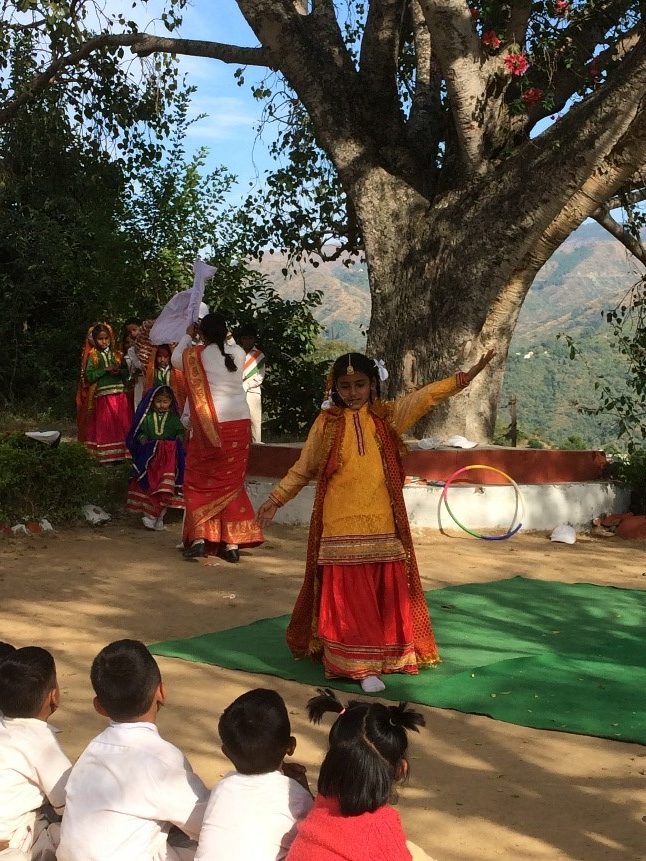Practice Insights > Insights from Social Contexts
Community Bonds Crucial for Retaining Children in School
Teacher: Laxmi Naithani
School: Government Primary School Kanda, Kaljikhal Block, Pauri District, Garhwal, Uttarakhand
By: Shipra Suneja
This article can be read in Hindi here.
The School
The Government Primary School Kanda is some 60 kilometres from Kotdwar (the closest city with a railway station) in the Pauri district of Garhwal, Uttarakhand. It is situated on a hilltop amidst a thick cover of trees that are spread over the wide hills of Garhwal. As we climbed the hill to reach the primary school, the bougainvillaea hanging from the extended roof of the school came into view. We were soon inside the school courtyard where approximately 30 children were present—standing in neat queues for the morning assembly. They sang songs of patriotism followed by a pledge, first in English and then in Hindi. The Hindi pledge had references to the love for their state of Uttarakhand, ‘Uttrakhand hamare desh ka mastak hai…hum ye vachan dete hain ke hum apne Uttrakhand ko koi nuksaan nahi pahuchne denge’ (Uttrakhand is the forehead of our country… we promise that we will not let it be harmed in any way). Bolstering the spirit of the students, was the Head Teacher, Laxmi Naithani, who walked energetically between the queues, holding her saree with one hand and singing along with them.

The children, then, sat down in a circle and introduced themselves. Each child got about five minutes to tell us a little about themselves, their family, their likes and so on. After they finished, Head Teacher, Laxmi, asked the ‘benaami’ children—those who are not yet enrolled in the school because they are underage but are allowed into school with their siblings—to speak up.
The school was a four-room building with toilets in the backyard. The classrooms were large and had tables and benches. On all walls, boards displayed charts and children’s artwork. The windows looked out at the hills and the rooms were well ventilated. There was a kitchen where the mid-day meal was being prepared and a large courtyard with plants all around. Laxmi and her students had sowed and nurtured these plants. Outside the classrooms, the walls of the school were covered with charts ranging from shapes and actions words to children’s wishes and government-schemes-related information. Several poems written by the children and their photos were hanging on strings from a wall. Laxmi explained to me the significance of each photo.
As we entered the grade V classroom, the children, smiling and stealing quick glances at each other, got up and greeted me in the usual sing-song unison. After a few general questions that I asked them, they said that they had some questions to ask me. And then one after the other, the children began to ask questions. In some sense, to me, it reflected the freedom of expression that the school seemed to be inculcating. I observed this being done in many other ways too, which I discuss later in this document.
Laxmi’s journey
Laxmi’s family home is in Kotdwar, a small town, 55 kilometres from the school, so she had taken a room in Satpuli, a village only a few kilometres away. She usually comes by a shared jeep but on some days, she walks to the school with the intention of chatting with parents on the way.
Laxmi is one of three sisters and has experienced poverty at some point in her life (hamne gareebi dekhi hai, she mentioned). She got her initial education in a government school in Landsdowne, a small town in the Pauri Garhwal district. As a child, she did not know what she wanted to become but whenever she played with her siblings or friends, she would become the teacher and gradually, she arrived at the decision that she would only do ‘teachergiri’ and nothing else.
Laxmi believes that the initial experiences that children have with their teachers play a crucial role in their lives. About the values she learned from her teachers, she mentions ‘discipline’ as the foremost, followed by ‘hard-work’. One of her teachers, in the early years, though very strict, was extremely devoted. Her devotion impacted Laxmi. About her later years as a student, she said that she was not given enough opportunity to express herself. Once a teacher in grade IX made her class run—take rounds of the school ground and Laxmi ran so well that the teacher picked her up for the running race. This was how her talent in sports was first discovered. Later, she went on to participate in several sports competitions.
Even though her family was poor and her father was not sure if he would be able to educate her, Laxmi insisted on completing graduation. She was good in sports, such as basketball and volleyball, in college—a champion for two years. The quality of working hard has been instilled in her since childhood. She went on to complete her CPEd (Certificate of Physical Education) and become a PT (Physical Training) teacher. Very soon, she was teaching primary school children and learning to teach rhymes, she began working with younger children.
After her initial years in a private school and a government school in Kinsur, Laxmi was transferred to GPS Kanda. The school with only 52 children was in shambles when she arrived. Initially, she was demoralized; unsure of how she would continue there, but it was her belief in the children’s willingness to learn that made her resolve to set things right.
Laxmi began by getting 65 new students admitted in grade I. There was only one tree in the premises, so she began planting more and nurtured the trees just like the children. In the beginning, teaching the early classes had seemed daunting, but later, she began to enjoy it because she realized how impressionable primary school children were. She taught them through stories and focused on maths because it was a subject she herself dreaded in her childhood. ‘When we ourselves have that weakness, we work hard on it with others,’ she told me. She set for herself some basic expectations and worked towards those.
Right from the beginning, Laxmi focused on sports activities and took her students to participate in various sports competitions. She has continued this practice and takes her students to competitions in nearby places, irrespective of whether others support her in this or not. Sometimes, she takes them on her own expense and has several times, fought with organisers who would send her students back because little importance is given to primary school children. Laxmi never gave up and parents supported her. And because her students continued to excel and win prizes, the doors for younger children in sports, were opened.
Laxmi’s teaching-learning process
Lakxmi mentioned that it worries her if her students do not learn in class and she then thinks of ways in which to teach them better. For example, one of the children was disinterested in lessons but she observed that he enjoyed gardening. She engaged him in planting saplings and taking care of the school garden. Gradually, the child began to learn and take an interest in school-work.
Laxmi does not fail to stress the importance of learning in order to teach. She says, ‘I am willing to learn anything that is new if it helps my children to learn better, and I do not shy away from technology, either.’ She even uses videos to teach in class.
Among her teaching strategies, Laxmi stresses the importance of knowing the child and her/his family; getting familiar with each child’s everyday routine. In the classroom, the first form of learning, she says, is through stories, poems and songs. Emphasizing the importance of a strong foundation, she believes that once the children acquire good oral language, they can move to writing, easily. The progress of her students is consistently tracked and children who need extra support are given additional lessons where required. To do this, she comes to school early. New concepts are introduced through games and in the morning assembly, maths tables are taught and repeated as the children exercise. In fact, a lot of focus is laid on the assembly where all children get the opportunity to speak while the rest listens attentively.
Laxmi brings along a story to school every day and teaches through it. In one of her classes that I observed, she told a story with incredible energy and passion using expressions and involving the children. In another class, she wrote a sentence on the blackboard and asked the children to add sentences to it to form a story. She linked it with the children’s everyday experiences.
In the practice of maths, Laxmi used practical examples—she cut rotis out of cardboard and asked children how many each wanted and counted them aloud while giving those to each. She also cut an apple to explain parts and the sum of the parts, after which, she distributed the apple among the children. During all this, she did not forget to ask the children, ‘Are you feeling sleepy?’, ‘Shall we sing a song?’ –ensuring that they were all attentive and interested. Children also had the freedom to walk around and find their own learning spaces.

Laxmi interacting with the children in a circle
Laxmi has sought the support of the other teacher in the school, and oftentimes, they worked together. She does not make very structured lesson plans and the day flows according to the pace of the children. Laxmi mentioned that she received support from the Azim Premji Foundation in the development of her teaching-learning material.
Laxmi spoke about a child who was growing up in very difficult circumstances and how she manages to work with him. This child had been to four schools before he came to this school. The shift was due to his parents’ shifting locations. Due to long periods of absence from school, he did not know how to read or write. Laxmi started working with him on the alphabets. She visited his home to involve the parents and found that the parents were living separately. The child’s mother was in the city, so Laxmi got in touch with her on the phone and continuously updated her. She decided to bring the child to school along with her, every day. From ensuring that the child’ nails are cut, to his understanding of lessons and relationship with other children, she has kept a close eye on him.
Relationship with the community
The families in the villages nearby, who send their children to school, are poor and face many hardships. Since the farming output is reducing every year, several families are moving to bigger towns. Many children are being left in the care of grandparents while their parents live in cities or are away working there for long durations. They do not get to spend time with their children. Alcoholism and domestic violence are other major concerns. So much so, that Laxmi refuses to hand over the money for the children’s uniform to their parents, for fear that it may be used to buy alcohol. She herself buys uniforms for the children and gives it directly to them.
Laxmi says that the parents are extremely supportive of the school and consider her as a family member. She is invited to weddings and she even contributes for these functions. She encourages parents to participate in the school activities; organizes community meetings and school functions for them to attend. Before she took over the school, the parents had never visited the school. She has asked the parents to contribute whatever time and resources they can to the school. According to her, family situations impact the learning of children, who must, at least, get a peaceful environment to study. She believes that from personal hygiene (she keeps shampoos, nail-cutters and soap in school) to emotional needs, the teacher is a part of all aspects of a child’s life. She is like a second parent to the children, she believes. She keeps the parents informed about the progress of their children in order to keep them involved and has laid down a clear expectation from them that they have to send their children to school every day.

About creating bonds with the community, she put it quite simply, ‘There is nothing much to it. All you have to do is be nice to them, say Namaste when you pass them by, ask about their children, their lives. I, sometimes, just sit with them and have tea.’
Some 10-12 mothers had been invited to the school to talk to us. Her students presented a few songs and dances from their annual day function and the mothers were offered tea and biscuits. The mothers expressed that Laxmi was the main reason that they were sending their children to school, ‘Laxmi madam bohot achchi hain. Hum bohot khush hain inse’ (Laxmi madam is very nice. We are very happy with her). They mentioned that Laxmi makes the effort to engage with the community and that she talks to them about their children out of concern and not in a manner of complaint.
Laxmi’s struggles
Laxmi spoke more about ‘fighting the system’ than of any other aspect that pulled her down. She recalled an instance that made her realise that she was capable of putting up a fight. A government official had objected to the expansion of the school. Laxmi stood up to him, got the parents involved and even spent nights in the school till the building was completed. At times, people have tried to dismiss her as a woman but she questioned it and did not let it come in the way of her work. In fact, recently, the road up to the school was laid due to her efforts in reaching the higher officials.
Her main concern now is that the number of children in the school has been consistently decreasing as families move to towns.
Laxmi also expressed her inability to work with children with disabilities. These children are enrolled in the school but do not attend as there is no arrangement for their pick-up. She admits her failure to do much in such cases or to work with children who just did not learn even after consistent efforts. She said, ‘jinme budhi hi nahi hoti unke saath kya karo?’ (What to do with those who do not have the capacity to learn?). She also expressed the need for a Special Education teacher in the school.
Her achievements
Laxmi received her first ‘Best Teacher Award’ in 2004, followed by the ‘State Award’ in 2006 and in 2015, she won the ‘President’s Award’. Laxmi says that she had never dreamed that she will be bestowed with these awards or that the children would give her so much love and the community, embrace her the way it has. Several of her children have got admission in the Navodya and Himjyoti schools. Her children have won several sports and singing competitions. For the last sixteen years, her students have been winning the antakshri (singing) competition held for primary schools. She proudly mentioned how her children (she calls them ‘mere bachche’) could jump through fire hoops.
Laxmi says that one of her personal victories has been that she has been using technology more and more (use of videos in class and using the internet to learn new ways to do things).
In conclusion
With a determined expression on her face, Laxmi states, ‘You can call this my madness if you want but my life is devoted to these children.’ Laxmi has assumed complete responsibility of running the school—from the building construction to children’s learning, their participation in competitions and maintaining relationships with the community.
Her interminable energy is contagious. She accepts what she does not know and is willing to learn from children also if required. She says, ‘I do not say “no” to anything, it’s not in my dictionary.’ She respects the children’s views and answers their questions patiently. It is her belief that children need opportunities to do what is expected of them. Her pedagogical practices reflect how she has included children’s natural way of learning into her lessons. She was aware of each child’s trajectory and focused on their interests besides the lesson. She uses storytelling very effectively. And although the focus still remained on learning letters in the traditional sense, she used different methods to engage the children. Disciplining has been an important aspect of school education for her—it does not imply complete submissiveness but the authority is always clearly established. She used several ways to discipline children, ‘We also show the stick but learning is not based on it.’
Laxmi is internally motivated and though the awards must be a constant source of encouragement, it is the desire to learn and educate children that gives her a constant push. The parents seemed to have complete faith in her. Several of them have continued to stay back in the village so that their children can complete grade V with Laxmi teacher. She showed concern about every child, parents, and the community. Laxmi believes that trust can bring parents closer to the school and eventually, ensure their support of their child’s education. She also mentioned that the villagers did not discriminate between small boys and girls and she was inculcating this in her children so that the discrimination does not surface even as they grow up.
Acknowledgements: I would like to thank Ms Laxmi for her enthusiasm with which she welcomed us to the school and shared her life story. I would also like to thank the children, the other teacher and support staff of the school for the conversations. I am grateful to my colleague Mr Sanjayji, member District Institute, Kotadwar, Azim Premji Foundation, who accompanied me to the school, facilitated the process and gave me keen insights about the school setting.


Great work by teacher, such people brings change in society.